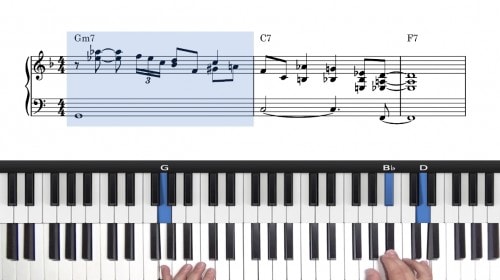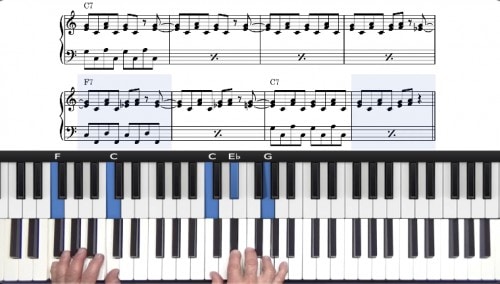Soloing & Improvisation Concepts
Welcome to this lesson on improvising over the F blues. We will learn some techniques for creating improvised solos and explore how we can build our melodic ideas and phrases.
The Importance Of Chord Tones
Nearly every phrase in blues improvisation leads to a consciously chosen chord tone, so knowing the chord tones and the different sound of each one is critical.
The root, third, and fifth are the most common "arrival" destinations, though the b7th can be too. In the non-minor blues, the third is the most important, and for many players, the most common arrival destination.
The Blues Scale & Chord Tones
We explore a framework for constructing idiomatic-sounding improvised phrases over the blues:
- The departure
- The middle part
- The arrival or resolution
The arrival moves out of the blues scale into a consciously chosen chord tone and amounts to a release of tension in the phrase.
Blues Licks On Hammond Organ
Blues licks are usually short phrases that can repeated, often many times in a row to build tension. These licks can stand alone or alternatively lead into a melodic improvised phrase.
Often a riff heightens tension through hemiola. This means the riff repeats on a cycle different from the basic time of the piece, e.g., three or five beats in a 4/4 tune.
Playing these smoothly requires good hand independence and lots of practice to avoid getting lost.
Find the notation of all licks covered in the Downloads section below.
Lesson Downloads
-
Tremolos Notation File Type: pdf
-
Contrasting Time Riffs Notation File Type: pdf
-
Improvised Solo Transcription File Type: pdf
-
Licks & Riffs Lesson Notation File Type: pdf
Practice Tips
-
Stick to the F blues scale throughout the F blues form. For example, do not change to Bb blues Scale on the IV chord Bb7.
-
Emulate Robert's blues licks and try to create your own examples using the 3-step framework of departure, middle, and arrival.
-
Experiment with tremolos between the 5 and b3 of the tonic. The 5 and b7 can also be used in a similar way.
-
Incorporate riffs that repeat on a cycle different from the basic time of the piece.
-
Transpose licks up a half step and then back down to build and release tension.
-
There's a vast world of great blues licks and riffs for you to mine on records. Check out these notable artists: Groove Holmes, Jimmy Smith, Jimmy McGriff, Jack McDuff, Charles Earland, Shirley Scott.
- More recent players include Tony Monaco, Larry Goldings, Joey DeFrancesco, Pat Bianchi, Mike LeDonne, Jared Gold, Brian Charette, and many others.







